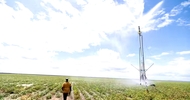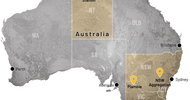What’s in a number? Why the struggle to quantify the global land grabbing crisis is part of the problem.
We work in a world obsessed with numbers – a campaign barely exists until you can sum it up in a neat, shocking statistic. But so far, numerous attempts to nail a headline figure for the amount of land being handed out to investors have failed to communicate the scale and urgency of the problem.
This lack of clarity cuts to the core of the land grab problem – secrecy. Because large land deals are routinely done behind closed doors, it’s very hard for anyone to know what is really changing hands and on what terms. This is as true for subsistence farmers trying to get their ancestral land back as it is for campaigners trying to demonstrate this is a global phenomenon which needs attention.
Take the Land Matrix website. In 2012, this ambitious interactive website was launched to track land investment deals globally, and stated ‘deals reported as approved or under negotiation worldwide between 2000 and 2010 amount to a total of 203 million hectares. An area equivalent to eight times the size of the UK’.
But soon after it launched this figure began to be challenged and since then has been repeatedly downgraded. This is partly because land acquisitions constantly change – some land deals are speculative, investors in others agree to a certain amount of land then take much more, whilst others are swiftly cancelled. However, the far more important reason for the reduction in the global figure is that we still simply don’t know who is leasing what in this murky sector.
Today, the Land Matrix reports 937 signed deals covering just 35.6 million hectares and a further 14.1 million hectares under negotiation – still approximately twice the size of the UK. Oxfam meanwhile claims 33 million hectares and GRAIN’s land grabbing database currently puts the figure at 416 deals over 35 million hectares. These figures are very likely gross underestimations because national-level statistics also reach into the millions – the figure for land acquisitions in Cambodia and Laos alone are 3.7 million hectares for example.
If deals were done in the open, much of this could be avoided. Communities would be able to see who was interested in acquiring their land and what they stood to lose. If leasehold terms or laws were broken, getting compensation and making sure those responsible were held to account would be easier. Meanwhile governments would be able to better weigh the potential social and environmental benefits of land deals versus the costs. In other words, the trade could be regulated like most others.
We are a long way from this now, but help is at hand. In 2012, Dealing with Disclosure, a report by Global Witness, the International Land Coalition and the Oakland Institute set out for the first time what tools governments, companies and citizens can harness to ensure that land investment is open and fair.
The report’s key principle is ‘if in doubt, disclose’. That means all contractual information should be made publicly available unless investors or governments can prove that doing so would harm commercial competitiveness or public interest. This puts the onus back on companies to prove they are not doing harm, rather than communities with little information or power having to prove how a land deal is negatively affecting them. The report also details how a more open investment environment could benefit governments and investors, for example minimizing the risks associated with operating behind closed doors.
Meanwhile in 2012 the UN Committee on Food Security adopted the Voluntary Guidelines on the Responsible Governance of Tenure of Land, Fisheries and Forests in the Context of National Food Security – the first international standard defining best practice for the way in which human rights, land and natural resources inter-relate.
We don’t know exactly how much land has been stolen in the global land grabbing crisis, or the precise number of people affected. But we do know it is widespread, it is happening right now and what action we can take to stop it. We urgently need regulations which open up the land sector so everyone can see who owns what land, before it is allocated to companies. Once that happens, we may even be able to agree on a neat global statistic to use in the headlines.
Josie Cohen has been Global Witness’ land campaigner since 2012. Follow her on Twitter at @josiecoh.













